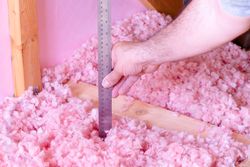Your Guide to Fiberglass and Radiant Barrier Insulation

Adding attic insulation to your home can increase both your energy efficiency and your overall comfort. However, it might be difficult to choose which type of insulation to get. Both fiberglass and radiant barrier insulation help keep your home warm in the winter and cool in the summer, but there are some significant differences in how they work and when it’s best to use each type.
What are the Differences Between Fiberglass and Radiant Barrier Insulation?
When talking about attic insulation, many people immediately think of fiberglass insulation—the fluffy, pink fiberglass material found in most homes. Fiberglass insulation is used to control the amount of heat your house loses or gains. The higher the insulation’s R-value, the more effective it is at keeping heat out in the summer and in during the winter.
On the other hand, a radiant heat barrier is designed to block heat and send it back into the atmosphere. In hot climates, some municipalities require homes to have radiant heat barriers as part of building code to keep homes cool and reduce energy usage.
What Are the Benefits of Each Insulation Type?
 In terms of overall comfort and energy savings, a radiant heat barrier has some advantages. Fiberglass attic insulation works to absorb heat, meaning it essentially just slows down the heating of the home. However, it also helps prevent heat from escaping in the winter, so it’s still necessary in cooler climates. With a radiant heat barrier, though, the warmth from outside is reflected away from your attic, preventing the heat from coming down through the ceiling. This can create a more comfortable environment overall. Ultimately, many homeowners choose to use both fiberglass insulation and a radiant heat barrier for their homes because they are designed to do different things.
In terms of overall comfort and energy savings, a radiant heat barrier has some advantages. Fiberglass attic insulation works to absorb heat, meaning it essentially just slows down the heating of the home. However, it also helps prevent heat from escaping in the winter, so it’s still necessary in cooler climates. With a radiant heat barrier, though, the warmth from outside is reflected away from your attic, preventing the heat from coming down through the ceiling. This can create a more comfortable environment overall. Ultimately, many homeowners choose to use both fiberglass insulation and a radiant heat barrier for their homes because they are designed to do different things.
How Does Attic Insulation Work?
If you’ve ever stepped into your attic on a hot summer day, you’ve likely noticed it’s significantly warmer than the rest of your house. That’s because your roofing materials absorb heat from the sun, and that heat radiates down into your attic. Fiberglass attic insulation will slow this process down, but a radiant heat barrier reflects that heat away from the attic and back toward the roof. As long as the reflective surface of the heat barrier faces open air and remains free of dust, it will help keep your home cool.
If you’re looking to keep your home more comfortable and make it more energy efficient, turn to All Season Insulation LLC for help. This locally-owned insulation company serves residents throughout northern Kentucky and Dayton and Cincinnati, OH. These knowledgeable experts can help you select the right attic insulation for your home and provide expert installation. Schedule a consultation with an insulation contractor by calling (513) 316-7622, or visit their website for more information.
About the Business
Have a question? Ask the experts!
Send your question

